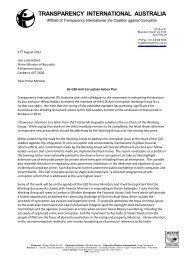'What works and why in community-based anti-corruption programs'
'What works and why in community-based anti-corruption programs'
'What works and why in community-based anti-corruption programs'
You also want an ePaper? Increase the reach of your titles
YUMPU automatically turns print PDFs into web optimized ePapers that Google loves.
What <strong>works</strong> <strong>and</strong> <strong>why</strong> <strong>in</strong> <strong>community</strong>-<strong>based</strong> <strong>anti</strong>-<strong>corruption</strong> programsCASESTUDY 12Box 3.12 Multi-sector Coalition – South KoreaIn 2005 four sectors of South Korean society; Political, Public, Economic, <strong>and</strong> Civil Society, cametogether to form the Korean Pact on Anti-Corruption <strong>and</strong> Transparency, or K-PACT. This social pactbr<strong>in</strong>gs together a national collective effort to <strong>in</strong>crease transparency <strong>and</strong> end <strong>corruption</strong>.K-PACT emerged from mount<strong>in</strong>g public discord towards Korea’s endemic <strong>corruption</strong> problems.Dogged by repeated slush fund <strong>and</strong> electoral sc<strong>and</strong>als, government’s claims to be clamp<strong>in</strong>g down on<strong>corruption</strong> were viewed with popular cynicism. Civil society <strong>anti</strong>-<strong>corruption</strong> groups were popp<strong>in</strong>g upacross the country, but with no national coalition or l<strong>in</strong>ks to the economic or public sector, theircampaigns were limited to sidel<strong>in</strong>e critiques of bus<strong>in</strong>ess <strong>and</strong> government.Capitalis<strong>in</strong>g on an expressed will<strong>in</strong>gness of the bus<strong>in</strong>ess <strong>and</strong> economic sector to <strong>in</strong>stigate reform<strong>in</strong>itiatives, <strong>and</strong> with national <strong>community</strong> support, TI-Korea proposed the formation of a quad-partitecoalition. With the sign<strong>in</strong>g of the social pact, each sector committed to national <strong>anti</strong>-<strong>corruption</strong>campaigns.K-PACT <strong>in</strong>volves sectoral commitments to address weaknesses to <strong>corruption</strong> <strong>and</strong> improve systems.For <strong>in</strong>stance:Public sector: improv<strong>in</strong>g local government transparency, reform<strong>in</strong>g Information Disclosure Acts <strong>and</strong>strengthen<strong>in</strong>g <strong>anti</strong>-<strong>corruption</strong> education; <strong>and</strong> improvement <strong>in</strong> public corporation's transparencyPolitical sector: strengthen<strong>in</strong>g of the National Assembly Ethics Committee, eradication of illegalpolitical fundsPrivate sector: improv<strong>in</strong>g account<strong>in</strong>g <strong>and</strong> audit st<strong>and</strong>ards, establish<strong>in</strong>g ethics, protection ofwhistleblowers <strong>and</strong> <strong>in</strong>formation disclosureCivil society: improvements <strong>in</strong> accountability <strong>and</strong> transparency of civil society, <strong>in</strong>troduction of CitizenOmbudsmanLogistical support is provided through the secretariat (K-PACT Council), assist<strong>in</strong>g with cooperationbetween participants <strong>and</strong> enforc<strong>in</strong>g the four agendas of <strong>in</strong>spection, evaluation, dissem<strong>in</strong>ation, <strong>and</strong>renewal of the Pact.The K-PACT is not a fixed framework. It is designed to be adapted to fit the different needs of varioussectors, spheres, <strong>and</strong> regions. For example, on the basis of K-PACT Korean medical <strong>and</strong>construction sectors have established their own pacts, br<strong>in</strong>g<strong>in</strong>g together relevant government, public,private <strong>and</strong> <strong>community</strong> stakeholders.Regard<strong>in</strong>g <strong>community</strong> <strong>in</strong>volvement, civil society groups <strong>in</strong> the K-PACT network represent 12 ofKorea’s 16 regions. Community groups receive K-PACT support for youth education, research <strong>and</strong><strong>in</strong>vestigation activities <strong>and</strong> monitor<strong>in</strong>g of local governments’ adm<strong>in</strong>istration, legislation <strong>and</strong> f<strong>in</strong>ances.The K-PACT Council <strong>and</strong> civil society organisations organize national public campaigns for occasionssuch as UN Anti-Corruption Day. A citizen charter is <strong>in</strong>cluded <strong>in</strong> K-PACT <strong>and</strong> citizens can be <strong>in</strong>cluded<strong>in</strong> K-PACT through organisations or as <strong>in</strong>dividuals.Key strengths● Results of K-PACT testify to the commitment from each sector to fulfil their commitments <strong>and</strong>move away from <strong>corruption</strong> practices. More that 85% of the top 500 South Korean corporations havesigned onto the pact. In just 12 months 10 laws have been passed, address<strong>in</strong>g issues raised by K-PACT.● The program is adopt<strong>in</strong>g a long-term view. Future goals <strong>in</strong>clude encourag<strong>in</strong>g greater publicparticipation <strong>anti</strong>-<strong>corruption</strong> activities <strong>and</strong> <strong>in</strong>creas<strong>in</strong>g the prom<strong>in</strong>ence <strong>and</strong> underst<strong>and</strong><strong>in</strong>g of K-PACT <strong>in</strong>the public arena.● K-PACT is adaptable to different sectors who can establish their own accountability <strong>and</strong>transparency pact <strong>based</strong> on the overarch<strong>in</strong>g pr<strong>in</strong>ciples of K-PACT.● Unlike many coalitions that dependent on members provid<strong>in</strong>g all logistical <strong>and</strong> resource support,the K-PACT is assisted by its own secretariat.- 30 -




